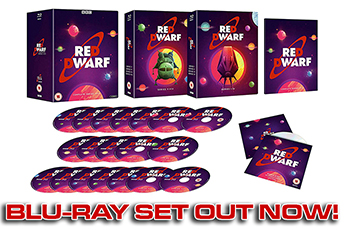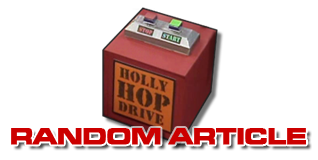Back to Earth 3D
Behind the scenes images bring on the third dimension.
24 December, 2010
It being the season for such things, reddwarf.co.uk presents small treat for your visual receptors - behind the scenes on Red Dwarf - Back to Earth in 3D!
Red Dwarf documentary cameraman and editor Nathan Cubitt has provided these anaglyph images. You can read his story below - but for now grab some red-and-blue 3D specs (you'll probably have a pair knocking around in a DVD case somewhere) and goggle at these backstage marvels!
Click images to enlarge.
If you're finding yourself without a pair of red and blue 3D specs, here are the images in the form of animated gifs.
Click images to enlarge.
We'll have more images next week, and the full set will be added to our gallery, but if you're a a bit of a camera geek and were wondering how these images were created, well, wonder no more. Brace yourself for a datablast!
"The camera is a Stereo Realist," Nathan explains. "They stopped making them in 1971, and they're very very solid! They're also Rangefinder cameras, so take a bit of time to set-up - click and shoot they aren't! It has two lenses, and very basic apertures, no metering, all very old-school. It takes 35mm film, but takes anything up to 56 images (28 twinned images) on a roll."
"Using film on such an old camera, outside shots work better. To grab studio images I needed to shoot 400ASA which increased the grain - but it was that or nothing! There's also something about not knowing how the images will turn out until you've processed them, and managed them..."
"Because the images are so close on the negative, the negative cannot be cut, and no one will make prints from it that I've found. Instead I scan them in using a Nikon 4000 film scanner with a neg-roll adaptor - each image has to be done by hand to make sure you get the whole bit, so it takes hours and hours."
"From the negative scans I then make animated gifs to check that the 3D works. From there the images go into Photoshop for colour matching (sometimes the two lenses being a few inches apart record the colours differently). Then the two images are printed side-by-side and viewed through a basic two-quid viewer - and then there it is, permanent 3D image in front of your eyes!"
"Of course you can also make red/blue anaglyphs, as we have here, or even lenticular images - although four lens cameras are better for that - and cross-eyed 3D images, but I prefer the side-by-side as it becomes a fixed 3D image with lots of detail. I just wish I'd had more time to get stereo images - but a lot of what I got were more for 'me' than probably of interest for others. Maybe next time..."
There are more wonderful Red Dwarf images in our gallery.






















